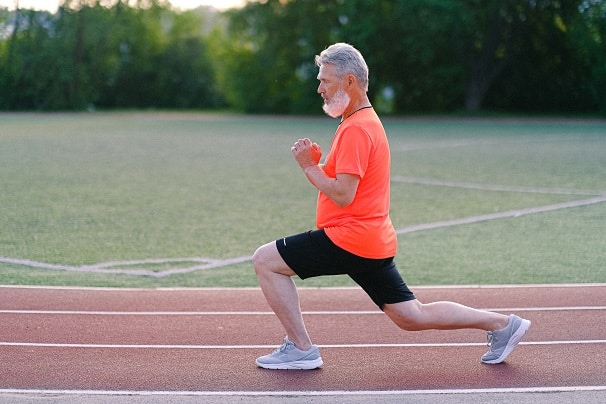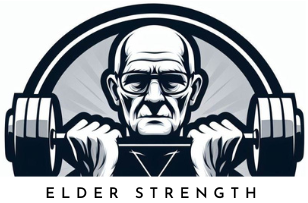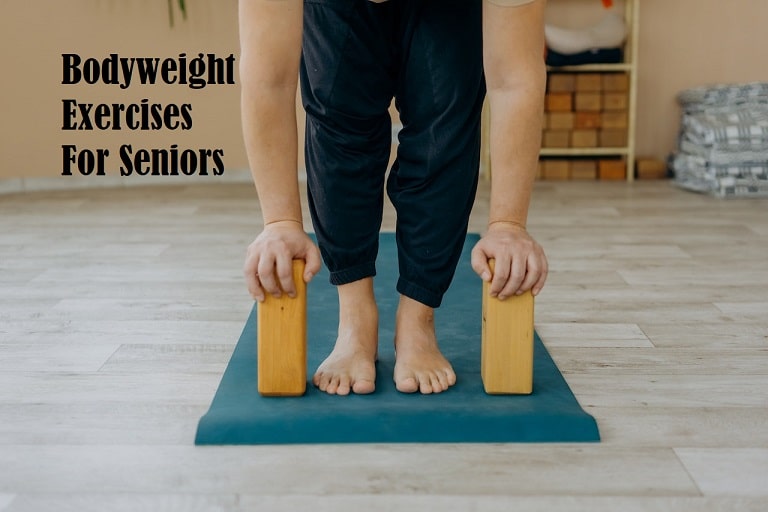In this article, you will learn about bodyweight exercises for seniors. Bodyweight exercises are very effective and they are also completely free!
Strength training is one of the best activities you can do for your health. As I’ve mentioned in almost every article on this website.
Strength training helps to prevent age-related loss of muscle mass and strength. This will help your metabolism, balance, and bone strength. Not to mention cardiovascular health and fat loss.
Strength training can even help with arthritis. Joint pain and back pain are also common ailments that strength training can reduce or even cure. Depending on the cause of course.
So strength training definitely has a lot to offer. The only downside is that it takes time, effort, and consistency to reap the benefits.
But what if I told you that time and effort don’t matter that much? It’s all about consistency.
There is no need for grueling workouts that last over an hour every day. Or special exercise equipment. Or a gym membership for that matter.
You can do effective strength training in the comfort of your own and you don’t necessarily even have to break a sweat.
All you need is a good 15 to 30 minutes a few times a week. But for this to work, it has to be almost every week of the year.
Sound too good to be true? Well, it isn’t.
Bodyweight Exercises For Seniors Vs. Gym
Let’s start by looking at what bodyweight training has to offer for you instead of going to the gym.
First of all, a good gym is a great place to do strength training. There’s variety, instructions, usually some social contact, etc. But above all, it’s a place dedicated to your workouts. I’m a firm believer in choosing the right environment for your goals.
But you might not like the idea of going to the gym. And I totally understand why. The gym can be an intimidating place, especially if you are going alone with zero experience.
Where do I start? What exercises I should do and how much? Will everyone watch me and think I look silly? What if I injure myself?
These are just a few examples of insecurities that keep people from starting a gym membership. And then there’s of course the cost.
If you are an athlete looking to improve performance or want to compete in powerlifting the gym is the best option of course.
Or if you want to become a bodybuilder and build a lot of muscle you can’t really skip the gym.
But if you are someone looking to just to improve their health and maybe look a bit fitter, bodyweight exercises done at home can definitely get you there.
Why Bodyweight Training Is So Effective
Bodyweight training is especially effective for health because you will use the same movement pattern you use in everyday life.
Bodyweight exercises are superior to gym machines in this sense. They develop very functional strength that helps
When you use your own body as resistance, you simultaneously improve your ability to move your body in space. This is called proprioception and it’s very important part of your balance.
Having good proprioception will help in fall prevention and it will help maintain your balance skills.I talked more about this in the article Calisthenics For Senior
But probably the most important thing about bodyweight exercise is that you can do it anywhere.
You don’t need special equipment and you don’t need a gym membership. All you need is your body.
This also means that bodyweight training doesn’t have to take much of your time. For many people exercise is just something that has to get done for health. It doesn’t have to be a lifestyle that eats up a lot of your time.
Going to the gym, changing your clothes, doing the exercises and maybe taking a shower after and once again changing your clothes easily takes hour and half or two hours.
A home workout can be done even in 5 minutes if you do it daily. That’s right. 5 minutes. But realistically if you want better results you should do around half and hour a few times a week.
But 5 minutes of bodyweight strength exercises can be surprisingly effective. Just pick an exercise for every day and do as many repetitions as you comfortably can. You
This literally takes 5 minutes and for most seniors, it can produce significant strength gain over time.
If you want a structured simple strength routine, check out my free weight training routine for seniors.
Best Bodyweight Exercises For Seniors
I like to split strength training into four main categories. And especially for seniors, there is a fourth important category that can be done with bodyweight exercises.
These categories are legs, pushing movements, pulling movements, and core exercises. By doing exercises in all these groups, you will exercise your whole body.
With strength training, it’s important to train all the major muscle groups to avoid muscle imbalances. This will help with posture as I explained in the article Good Posture Exercises For Seniors
The fourth important group for seniors is balance exercises. It’s very easy to train your balance skills at home with certain bodyweight exercises.
Bodyweight Exercises For Seniors: Legs
The leg muscles are the most important muscle group for seniors so let’s start with them. Strong legs help you stay functional and independent as you age. When you lose too much leg strength, moving around becomes strenuous or
There are two excellent bodyweight leg exercises that are all you need to maintain strong legs as you age. The squat and the lunge.
The Squat
The squat is the king of all leg exercises. You’ve performed thousands of squats during your life and that has helped you maintain leg strength.
Despite this, many people struggle with performing a full squat. This is because we sit on relatively high seats most of the day. Chairs, car seats, and even the toilet seat are so high that there is no need to do deep squats every day.
But the deep squat is an excellent bodyweight exercise that builds mobility and strength in the whole body.
The squat is both a very simple and very complex exercise. Depending on if you can do them naturally.
If it comes naturally to you and you have good flexibility you simply sit down between your legs and stand back up.
But if you have flexibility issues or have very weak legs relative to your weight, the squat can be too demanding to try out cold.
And you might not even be able to get into a squatting position due to flexibility issues.
This is where assisted squats come to play. In an assisted squat you hold on to something sturdy while sitting down. This reduces weight and allows you to maintain balance.
You can learn more about the assisted squat in the article Squats For Seniors and Weak Legs On Seniors.
Lunges
Lunges are a more demanding exercise that also challenges your balance more than the squat.

Because lunges are harder and offer more resistance I recommend you start with the easiest variations of squats before progressing into lunges.
Once you can do for example 20 bodyweight squats relatively easily you can start replacing the with lunges. In the lunge, you will step forward with one leg
This will activate the muscles a bit differently and more importantly, it will require more strength in the front leg. The rear leg will assist, so it’s not twice the weight of a squat. But it’s significantly more.
This also means that the risk of injury with lunges is higher. Especially for the knees. That’s why it’s important to build strength with squats (and assisted squats).
I also recommend you do these by holding on to something at first. This will help reduce the resistance and also help you maintain balance as the lunge can be surprisingly hard.
You can learn more about the lunge in the article Lunges For Seniors.
Bodyweight Exercises For Seniors: Pushing
Pushing movements are exercises that involve a large portion of the upper body. They mainly activate the chest, shoulder, and tricep muscles. But as with all bodyweight exercises, they help the whole body function as a whole.
Push-up
The main movement for push is the push-up. It’s simple, effective, and can be modified for different strength levels. Another great exercise is the dip. But bodyweight dips are an advanced movement that’s too strenuous for most seniors so we will focus on the push-up.

In a pushup, you will lay on the ground or against a wall facing towards them. You will the push your body off the floor or wall until your arms are fully extended. You then lower yourself down again and repeat the exercise.
Push-up resistance can be modified for different strength levels. The easiest variation is a wall push-up. In this variation, you will actually stand and push your body away from a wall. This is obviously much easier since you are lifting only a fraction of your body weight.
The next variation is the knee push-up. In this variation, you will be on the floor but on your knees instead of toes like in the full push-up. This will shorten the leverage and reduce weight significantly.
You can learn more about push-ups and variations in the article Push-Ups For Seniors.
Shoulder press
One of the more difficult movement patterns to train with bodyweight exercise is an overhead extension or shoulder press. This is easier to train with an external weight like a dumbbell or water bottle.

But for most seniors doing an overhead extension with just your arms is beneficial. In this exercise, the key thing is to think about raising something overhead.
It’s a variation of the push-up but instead of targeting the pectorals, you will target more of your shoulder muscles.
You can learn more about this exercise in the article Shoulder Press For Seniors
Bodyweight Exercises For Seniors: Pulling
Pulling movements train the upper back and the biceps. They are also great for grip strength as you are either hanging on to something or holding significant weight.
Pull-ups are the most effective and well-known pulling exercises. The problem with bodyweight pulling exercises is that they are hard to scale down.
It can be modified a lot, but all the variations are relatively advanced and too strenuous for most seniors.
Training the pulling movements is much easier in a gym because you can use different kinds of machines designed for them. This includes lat pulldown machines, seated cable rows, and different kinds of rowing machines.
That’s why I recommend using a row variation with an external weight for the back. You can use a dumbbell, a kettlebell, or a water jug for example.
You can learn how to do the bent-over row with these weights in the article Kettlebell for seniors.
Bodyweight Exercises For Core Training
People often mix the core with abs but it actually means your whole midsection. This includes several muscle groups so it’s more important to understand its function.
The function of the core is to support your spine when lifting something heavy or just moving your body. This helps to prevent injuries and increases the strength you can produce between your legs and arms.
There are a lot of different kinds of core exercises. But for the sake of simplicity and effectiveness, there are just two you will need.
The plank is one of the most effective core exercises. It improves all the core muscles and builds isometric strength in your core.
In a plank, you will lay on the ground like in a push-up but you can support your upper body on your elbows. Your back and hips need to be flat so don’t slouch or raise your butt. Activate your abs and hold the position as long as possible.
With planks, the aim is to increase the time you can stay in this position. There are no repetitions. You can learn more about this exercise in the article Planks For Seniors.
Just like push-ups, the plank can be made easier by staying on your knees.
Crunches
The other exercise I recommend is crunches. Crunches are a variation of sit-ups that are really effective for the abdominals.
The crunches are done by laying on the floor on your back. You then raise just the upper part of your upper body while your lower back remains on the ground. This will cause a very strong activation of the abdominals.
You can learn how to perform crunches in more detail in the article Sit-ups for seniors.
While the core is not just abs, they are the most important muscle group of the core. With these two exercises, you can train the core quite effectively at home.
Bodyweight Exercises For Balance
Finally, there are a lot of balance exercises you can do with body weight.
As I mentioned earlier, squats and lunges are actually great for your balance. And so are any core exercises.
But balance is a skill so more specific training is also beneficial. Anything that challenges your balance will help to improve it.
One-leg stands, side steps, and balance board training are good examples of effective balance training you can do at home.
Balance training itself is a large topic I won’t cover in detail in this article. But because it’s so important for seniors, I wanted to mention it and share these resources:
Standing Balance Exercises For Seniors
Printable Balance Exercises For Seniors
Best Balance Boards For Seniors
Conclusion
I hope you found these ideas for bodyweight exercises for seniors useful. If you have any questions, don’t hesitate to leave them in the comments section below and I will get back to you.
As you learned, bodyweight exercises are definitely a great way to do strength training in the comfort of your home. And the best thing is that they are free to do.
More importantly, it doesn’t have to take much time to do them. With bodyweight exercises, you can train your whole body in a few minutes per day. The trick is to stay consistent though.
I love to hear feedback from my readers so all suggestions and questions are welcome. So what are your thoughts on bodyweight exercises and do plan to use them?

